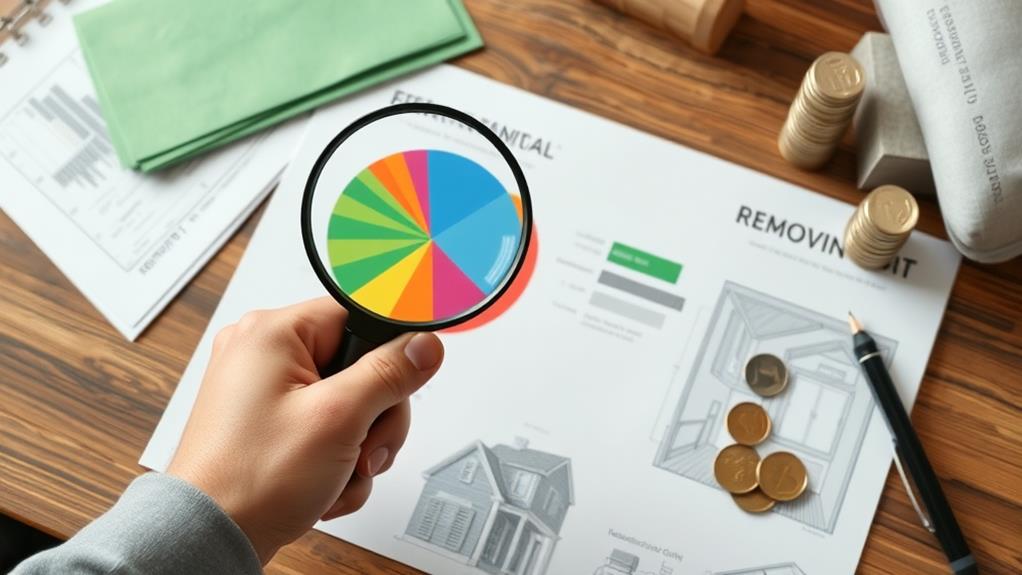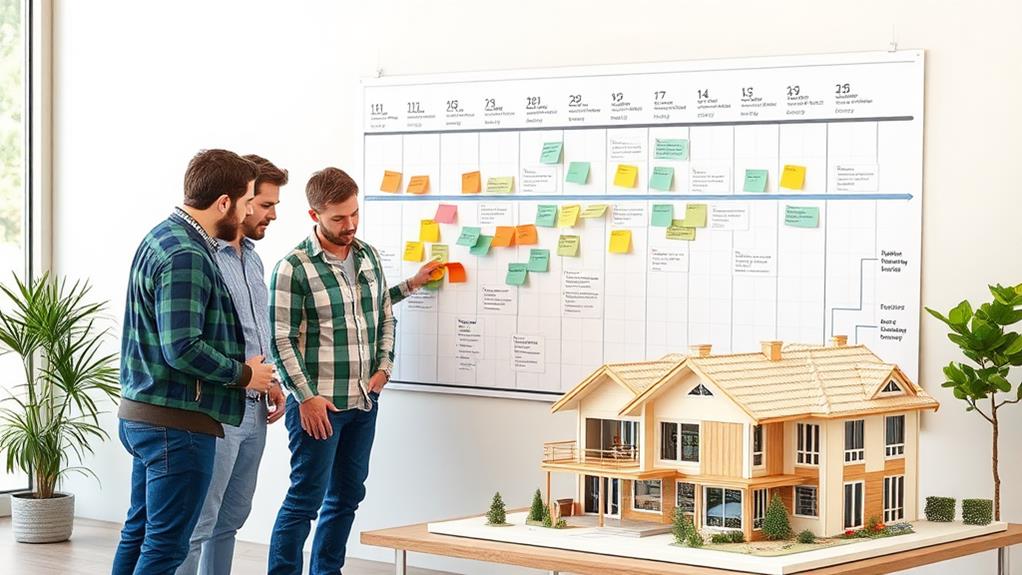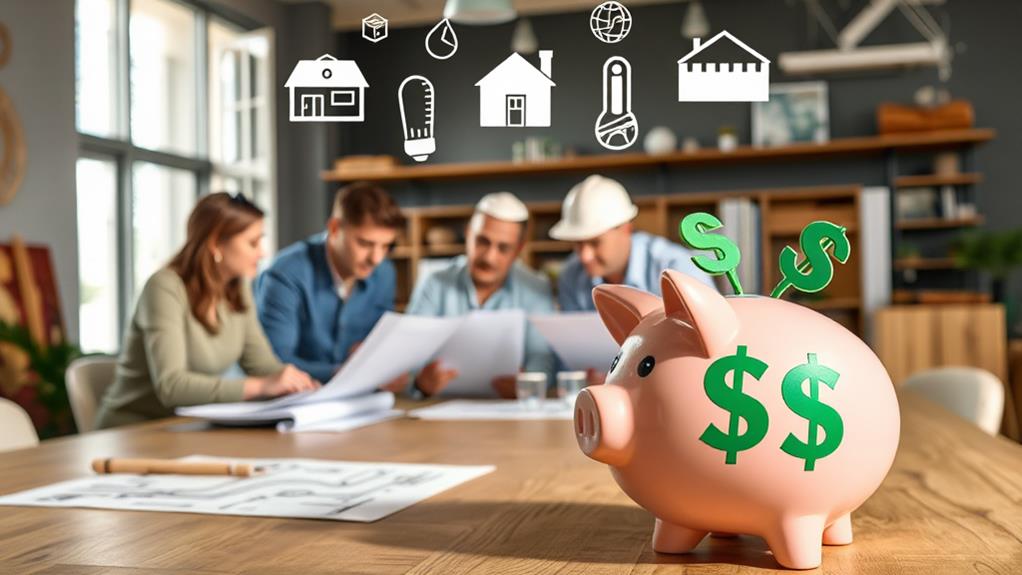Conducting a post-project review for home renovations with eco-friendly materials involves setting clear objectives, gathering comprehensive project data, and analyzing financial performance. Evaluate material choices based on lifecycle assessments, certifications, and long-term durability. Assess the timeline and workflow, identifying any challenges faced during the renovation process. Review initial budget estimates against actual costs, and evaluate the effectiveness of cost-saving measures. Gather feedback from contractors, suppliers, and homeowners to identify lessons learned. This systematic approach helps improve future renovation projects by refining budgeting strategies and material selection. By implementing these steps, you'll be better equipped to tackle your next eco-friendly home renovation.
Setting Review Objectives

Three key objectives should guide your review of eco-friendly home renovation materials: cost-effectiveness, environmental impact, and long-term durability. When setting your review objectives, focus on these critical aspects to ensure a comprehensive evaluation of your renovation choices.
Cost-effectiveness involves analyzing the initial investment against long-term savings. Compare the prices of eco-friendly materials to conventional options, factoring in potential energy savings, tax incentives, and reduced maintenance costs.
Environmental impact assessment should examine the entire lifecycle of materials, from production to disposal. Consider factors such as carbon footprint, recyclability, and the use of renewable resources. Evaluate how these choices align with your sustainability goals.
Long-term durability is crucial for both economic and environmental reasons. Assess the expected lifespan of materials, their resistance to wear and tear, and maintenance requirements. Durable materials reduce the need for frequent replacements, minimizing waste and resource consumption over time. Additionally, consider the materials' adaptability to changing needs and technologies, ensuring your renovation remains relevant and efficient for years to come. By focusing on these objectives, you'll make informed decisions that balance eco-friendliness with practical and financial considerations.
Gathering Project Data
Gathering project data is a crucial step in budgeting for eco-friendly home renovation materials. This process involves collecting comprehensive information about the renovation project, including the scope of work, specific materials needed, and current market prices for eco-friendly alternatives.
Begin by creating a detailed inventory of all required materials, categorizing them by type and function. Research sustainable options for each category, noting their costs, availability, and environmental impact. Consult with suppliers and contractors to obtain accurate pricing information and potential bulk discounts for larger quantities.
Next, assess the energy efficiency of your home and identify areas where eco-friendly materials can have the most significant impact. This may include insulation, windows, appliances, and lighting fixtures. Gather data on the long-term energy savings and environmental benefits of these upgrades to justify potentially higher upfront costs.
Analyzing Financial Performance

Analyzing financial performance is a critical step in budgeting for eco-friendly home renovation materials. This process involves evaluating the costs and benefits of using sustainable materials compared to conventional options. Begin by reviewing the initial cost estimates for eco-friendly materials against actual expenditures. Identify any discrepancies and investigate the reasons behind them, such as unexpected price fluctuations or changes in material availability.
Next, assess the long-term financial implications of choosing eco-friendly materials. Calculate potential energy savings, reduced maintenance costs, and increased property value resulting from sustainable renovations. Compare these benefits to the upfront investment to determine the overall return on investment (ROI). Consider factors such as payback periods and lifecycle costs when evaluating the financial performance of different eco-friendly options.
Analyze the impact of any tax incentives, rebates, or grants received for using sustainable materials. These financial incentives can significantly affect the overall project budget and should be factored into the performance analysis. Finally, examine how the use of eco-friendly materials aligns with your renovation goals and budget constraints, ensuring that the chosen options provide the best balance between sustainability and financial feasibility.
Evaluating Eco-Friendly Material Choices
When evaluating eco-friendly material choices for home renovations, it's essential to consider a range of factors beyond just cost. Environmental impact, durability, maintenance requirements, and long-term energy efficiency all play crucial roles in determining the overall value of eco-friendly materials.
Begin by researching the lifecycle assessment of potential materials, examining their production processes, transportation requirements, and end-of-life disposal options. Look for certifications such as FSC (Forest Stewardship Council) for wood products or Energy Star for appliances and fixtures. Consider the embodied energy of materials – the total energy required for extraction, manufacturing, and transportation.
Evaluate the longevity and maintenance needs of eco-friendly options. While some may have higher upfront costs, their durability and low maintenance requirements can lead to significant long-term savings. Additionally, assess the potential for energy savings through improved insulation, efficient windows, or sustainable heating and cooling systems.
Consult with green building experts or contractors experienced in eco-friendly renovations to gain insights into the best materials for your specific project. They can provide valuable information on local availability, installation requirements, and potential rebates or incentives for using sustainable materials.
Assessing Timeline and Workflow

To effectively budget for eco-friendly home renovation materials, a thorough assessment of the project timeline and workflow is crucial. This step involves carefully planning each phase of the renovation, from demolition to final touches, and allocating appropriate time for sourcing and installing eco-friendly materials.
Begin by creating a detailed timeline that accounts for potential delays in acquiring sustainable products, which may have longer lead times than conventional materials. Factor in any specialized installation procedures required for eco-friendly options, as these may impact the overall project duration. Consider seasonal factors that could affect the availability or installation of certain materials, such as weather-dependent exterior work.
Next, develop a comprehensive workflow that outlines the sequence of tasks and identifies critical path activities. This will help optimize material ordering and delivery schedules, minimizing on-site storage requirements and reducing the risk of damage to eco-friendly products. Coordinate with suppliers and contractors to ensure smooth integration of sustainable materials into the renovation process. By meticulously assessing the timeline and workflow, you can more accurately budget for eco-friendly materials and avoid costly delays or disruptions during the renovation.
Identifying Lessons Learned
The process of identifying lessons learned is a valuable step in budgeting for eco-friendly home renovation materials. By reflecting on the project's successes and challenges, homeowners can refine their approach for future renovations and make more informed decisions about sustainable materials.
Begin by analyzing the initial budget estimates against actual costs. Identify areas where eco-friendly materials exceeded or fell below expectations in terms of price and performance. Consider factors such as availability, shipping costs, and installation requirements that may have impacted the overall budget. Evaluate the effectiveness of cost-saving measures implemented during the project, such as bulk purchasing or sourcing from local suppliers.
Assess the durability and maintenance needs of the eco-friendly materials used. Determine if any unexpected issues arose and how they were addressed. Review energy efficiency improvements and their impact on utility costs. Gather feedback from contractors and family members about the renovation process and the performance of sustainable materials. Document these insights to create a comprehensive list of lessons learned, which can serve as a valuable reference for future eco-friendly home improvement projects and help optimize budgeting strategies.
Creating Action Plans

Action plans serve as essential roadmaps for implementing eco-friendly home renovation projects within budget constraints. These plans outline specific steps, timelines, and resource allocations necessary to achieve sustainable renovation goals while maintaining financial prudence.
To create an effective action plan, start by prioritizing eco-friendly materials and strategies based on their environmental impact and cost-effectiveness. Establish clear objectives, such as reducing energy consumption or minimizing waste, and set measurable targets for each goal. Break down the renovation project into manageable phases, assigning responsibilities and deadlines to team members or contractors.
Include a detailed budget breakdown for each eco-friendly material or technology, accounting for potential cost fluctuations and unexpected expenses. Research and identify reliable suppliers of sustainable materials, comparing prices and quality to ensure the best value for your investment. Consider incorporating energy-efficient appliances and systems into your plan, factoring in long-term savings on utility bills.
Develop a contingency plan to address potential challenges or budget overruns, allowing for flexibility in material choices or project scope if necessary. Regularly review and update the action plan throughout the renovation process, adjusting strategies as needed to stay on track with both sustainability goals and budget limitations.
Frequently Asked Questions
How Often Should Post-Project Reviews Be Conducted for Home Renovations?
Post-project reviews for home renovations should ideally be conducted after each significant project. However, for ongoing or multi-phase renovations, quarterly or bi-annual reviews can be beneficial. The frequency may vary depending on project complexity and duration.
Who Should Be Involved in the Post-Project Review Process?
The post-project review process should involve key stakeholders, including the homeowner, contractor, architect (if applicable), project manager, and any specialized tradespeople. It's beneficial to include suppliers and subcontractors for a comprehensive evaluation of the renovation project's outcomes.
What Tools or Software Can Streamline the Post-Project Review Process?
Let's dive right in. Tools like project management software (e.g., Trello, Asana), collaborative document platforms (Google Docs), and survey tools (SurveyMonkey) can streamline post-project reviews by organizing feedback, tracking action items, and facilitating team communication efficiently.
How Long Does a Typical Post-Project Review Take to Complete?
The duration of a typical post-project review varies depending on project complexity and scope. Generally, it can take anywhere from a few hours for small projects to several days for larger ones. Thorough reviews may extend to a week or more.
Can Post-Project Reviews Be Beneficial for Small-Scale Home Improvement Projects?
Ironically, some might think post-project reviews are overkill for small home improvements. However, these evaluations can be incredibly beneficial, offering valuable insights into budget management, time efficiency, and overall satisfaction—even for minor projects like repainting a room.
Conclusion
A comprehensive post-project review is crucial for improving future home renovations, especially when incorporating eco-friendly materials. The case of the Johnson family's kitchen remodel illustrates this point: by analyzing their material choices, budget adherence, and timeline management, they identified areas for improvement in sustainable sourcing and cost estimation. Implementing lessons learned and creating actionable plans based on these insights can lead to more efficient, environmentally conscious, and cost-effective renovations in the future, ultimately enhancing both the homeowner's experience and the project's overall sustainability impact.

